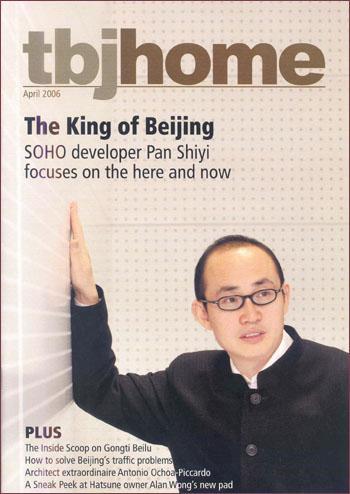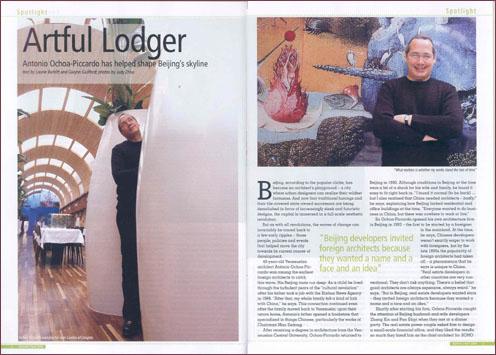
>>Antonio Ochoa-Piccardo has helped shape Beijing's skyline
Beijing,according to the popular cliche,has become an architect's playground a city where urban designers can realize their wildest fantasies. And now that traditional hutongs and their tile-covered state-owned successors are being demolished in favor of increasingly sleek and futuristic design the capital is immersed in a full-scale aesthetic revolution.
But as with all revolutions,the waves of change can invariably be traced back to a few early ripples those people,policies and events that helped move the city towards its current course of development.

49-year-old Venezuelan architect Antonio Ochoa-Piccardo was among the earliest foreign architects to catch this wave. His Beijing roots run deep;As a child he lived through the turbulent years of the cultural revolution after his father took a job with the Xinhua News Agency in 1968. After that my whole family felt a kind of link with China, he says. This connection continued even after the family moved back to Venezuela upon their return home,Antonio's father opened a bookstore that specialized in things Chinese,particularly the works of Chairman Mao Zedong.
After receiving a degree in architecture from the Ven-ezuelan Central University,Ochoa-Piccardo returned to Beijing in 1990. Although conditions in Beijing at the time were a bit of a shock for his wife and family he found it easy to fit right back in. I found it normal [to be back] but I also realized that China needed architects-badly, he says,explaining how Beijing lacked residential and office buildings at the time. Everyone wanted to do business in China but there was nowhere to work or live. So Ochoa-Piccardo opened his own architecture firm in Beijing in 1993-the first to be started by a foreigner he says,Chinese developers weren't exactly eager to work with foreigners but by the late 1990s the popularity of foreign architects had taken off a phenomenon that he says in unique to China. Real estate developers in other countries are very conventional. They don't risk anything. There's a belief that good architects are always expensive,always weird. he says. But in Beijing,real estate developers wanted stars they invited foreign architects because they wanted a name and a face and an idea.
Shortly after starting his firm,Ochoa-Piccardo caught the attention of Beijing husband-and-wife developers Zhang Xin and Pan Shiyi when they met at a dinner party. The real estate Power couple asked him to design a small-scale financial office,and they liked the results so much they hired him as the chief architect for SOHO New Town short for Small Office Home Office ,which now ranks among Beijing's most famous developments. Honing in on Beijing's lack of small-scale offices at the time,Ochoa-Piccardo designed SOHO for China's new breed of professional by crafting rooms with a minimalist spirit that could function as either home or office environments. Units in SOHO New Town sold out at breakneck speed.

Around 2000,Zhang Xin came up with another ambitious idea:contemporary residential structures that would showcase the work of Asian architects. Together with Ochoa-Piccardo,Zhang looked for the right site,and the two finally decided on a location at the base of the Great Wall. The original idea which Ochoa-piccardo calls extremely ambitious in scope,was eventually scaled down to twelve architects who developed eleven residences and one clubhouse in a project called the Commune at the Great Wall.
Ochoa-Piccardo's contribution was the Cantilever House-the structure that helped put his name on the international map. Made primarily from bamboo,brick and wood,this innovative structure is cantilevered on three sides and supported by two concrete walls on a small mountain slope. Arooftop garden,complete with a small pond,affords a spectacular view of the Great Wall,while four bedrooms and a spacious living room make up the interior.
The house demonstrates Ochoa-Piccardo's desire to integrate form and function. This ethic is evident in some of his other prominent projects,which include the angled mirror at the Icehouse and the linear dining room topped with an arched ceiling at Garden of Delights. Skylights that soften sunlight by day channel moonlight by night. I don't think I have a style - style is something very rigid he says,explaining that many architects use designs to make a statement and thereby force people to adapt to uncomfortable spaces.
Ochoa-Piccardo also thinks that most of the developments that have gone up around Beijing tend to stifle urban life. The block are too big and the city too spread out to encourage walking ,he says. The sense of urban life suffers for it. He also blames the market:Because developers who win bids tend to buy huge chunks of land a single design is reiterated across a whole space,bricking the city into homogenous cells. There is no natural sense of human scale between buildings, he explains,He tried to avoid this problem when designing SOHO by situating its buildings so that they were never directly in front of each other. In addition to ensuring that the towers were never in each other's shadows,this also created what he calls an intimate scale.
For now,Ochoa-piccardo plans to continues working to change Beijing's landscape according to his principles. Architecture is what brought me here,and architecture is what will keep me here, he states. He is currently working on clubhouses for the Orchid Garden complex near the Western Academy and designing a housing development in western Beijing for a Singaporean developer. There's no question he's achieved prominent status,but he's not over-confident. I am a well-known Venezuelan architect,but being well known does not mean anything to me. What matters most is if my works can pass the test of time. Will the houses and buildings be attractive in years the come





